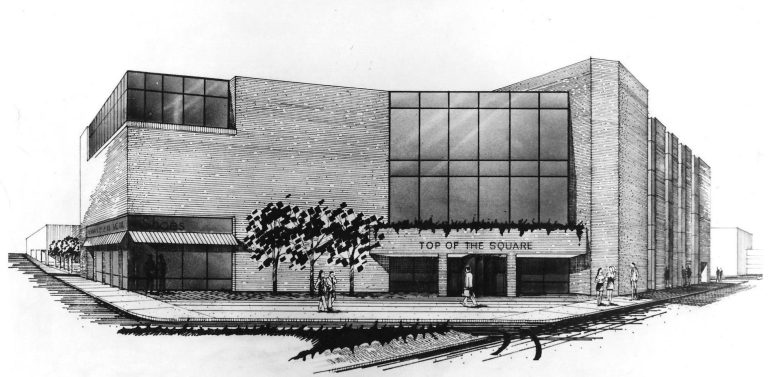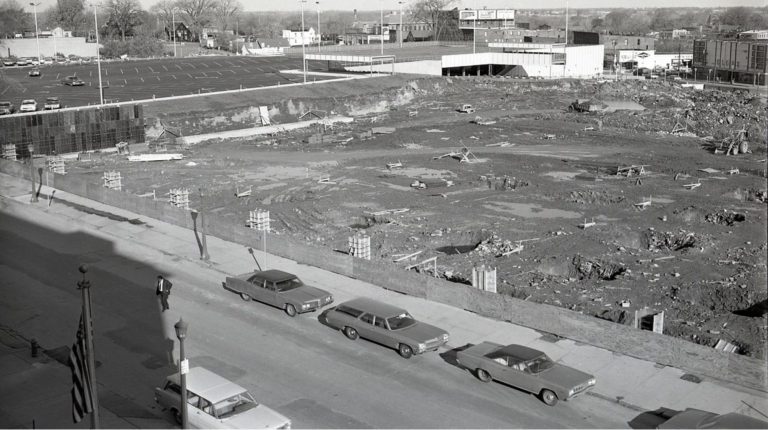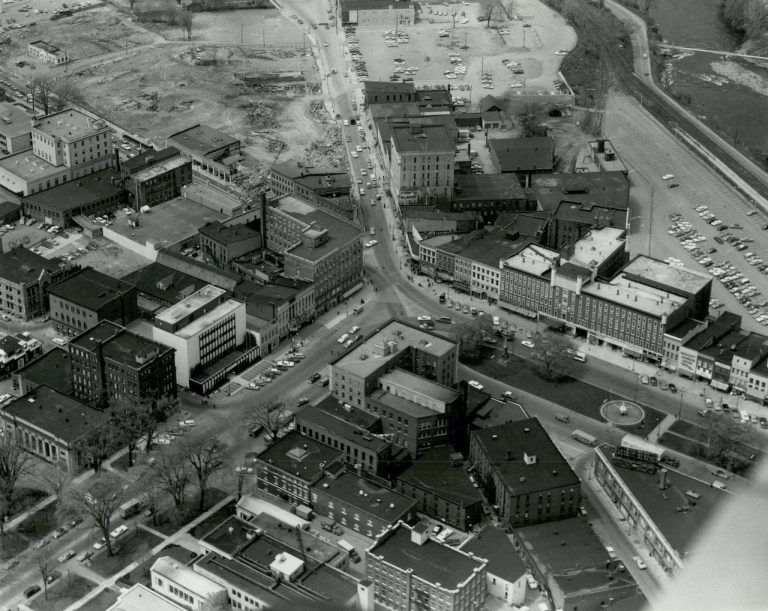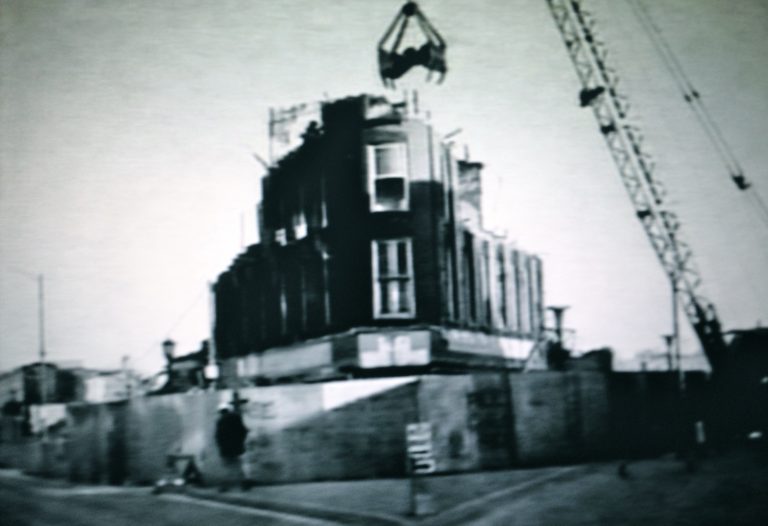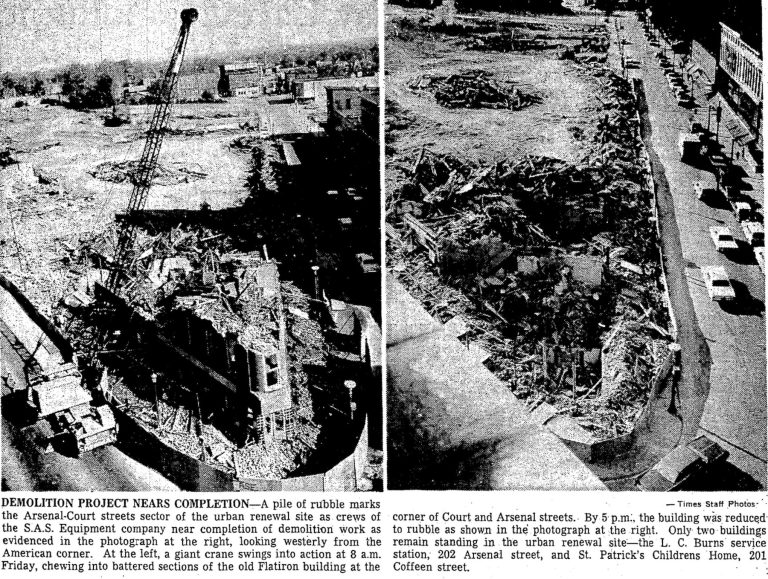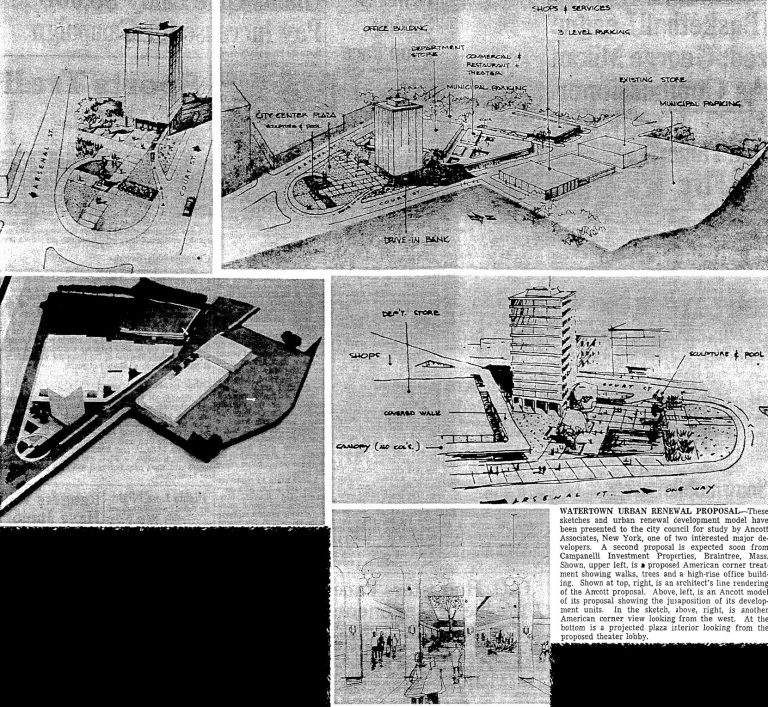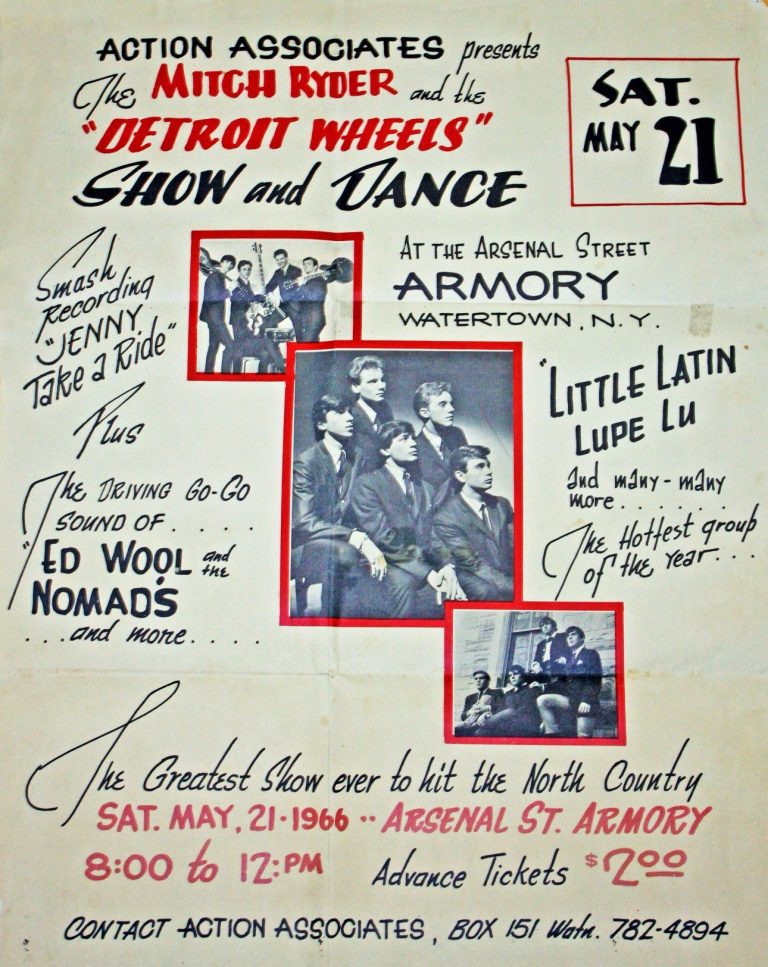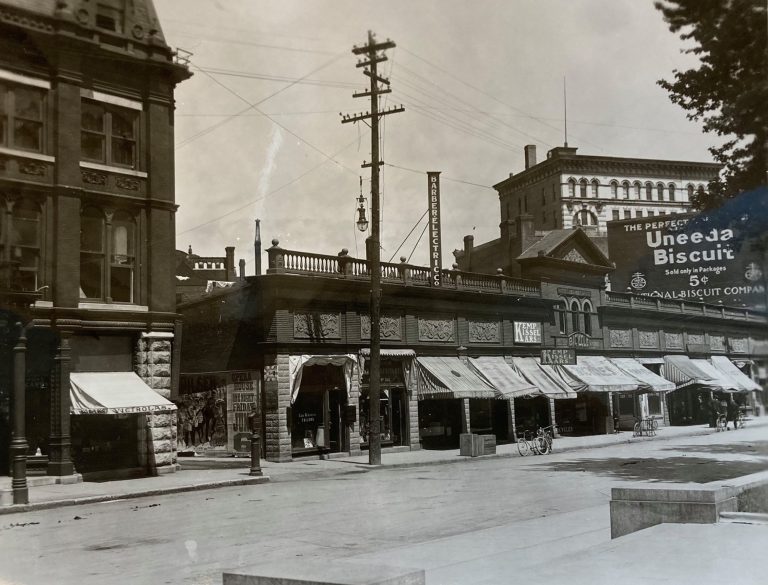Watertown Urban Renewal Crawls To The Finish Line
As the Watertown Urban Renewal project turned the calendar year into 1965, more questions still floated about with very few answers. With no developers contracted yet, the city was spinning its wheels with what would become of the “renewal” once the demolition portion, which hadn’t even started yet, was completed. Adding to the uncertainty was the retirement of 71-year-old urban renewal director Roy F. Hayes, who, for better or, as his replacement later posited, worse, had helmed the effort.

If you need to catch up on the Watertown urban renewal series, you may follow the respective links for their articles, Part 1 (1958-1960), Part 2 (1961 – 1962), and Part 3 (1963 – 64).
Once the city received the official document on concurrent prices for the properties in the Court-Arsenal Street sector from the regional U.R. Headquarters, they could begin the property acquisition process, either by agreements through negotiations or by condemnation. It would also enable the city to negotiate with potentially interested developers to enter contractual agreements. Both of these would become factors in more delays to come and illuminate the poor planning involved.
While Roy F. Hayes was retiring in January, it didn’t necessarily mean he was going anywhere soon. Mayor John H. Galvin, who was elected the city’s youngest mayor ever at the age of 32, sought to retain Hayes’s service as an administrative assistant working directly with him at a salary of $10,000 a year. The city council unanimously voted its approval but limited the tenure to a six-month contract a little over a week later. Hayes’s replacement was found in Anthony Vallone of Binghamton, who, as was noted, was very critical of the project’s leadership and professionalism.

On January 5th, the city council received good news, with a caveat that would cause further delays. The Watertown Daily Times reported–
Watertown’s city council has been authorized to offer $1,776,470 for 37 of 44 properties involved in this city’s multi-million-dollar urban renewal development, but a third appraisal has been ordered by the federal regional office of seven other parcels.
The properties are: The city hall, St. Patrick’s orphanage, the Avon Theater, Bradley properties on Arsenal and Court Streets, and the Sullivan properties—The Flatiron buildings at the apex of Court and Arsenal Streets, and the Unity Building.
By the end of the month, the city council was expecting the American Urban Corporation, New Haven, Conn., to submit a proposal for Watertown urban renewal construction at the cost of between $5,000,000 and $7,000,000. At last, the council felt as though the (wrecking) ball was moving in the right direction.
The very next day, Anthony F. Vallone, in an attempt to get the program moving, met with business owners that, in getting the area ready, tenants and owners should not “plan on spending next Christmas here,” later clarifying it was their intentions to have “a great many of the businesses in the urban renewal area” relocated by then.

In mid-February, the city council had taken its third major step in the Watertown urban renewal project by authorizing the city treasurer to issue and sell notes in what was expected to cover over $2,000,000 for project acquisition and site preparation. According to Mayor Galvin, after federal reimbursement, the city’s expected share of the costs would be between $350,000 and $500,000.
The notes would allow the city to expedite the efforts it had direct control of at the time, being the negotiation of 44 properties, however, the program wasn’t moving fast enough and, at the beginning of March, it was stated that the demolition of the Court-Arsenal Streets urban renewal area would not take place until 1966, leaving businessmen wanting to stay in their sector free to pursue their interests until the start of the 1966 construction season.
The city furthered this by stating, “no plan for demolition, with the possible exception of the old Court Street city hall, will be made until a developer has signed a contract,” according to City Manager Ronald G. Forbes. A few weeks later, the city council made a formal policy statement assuring businessmen in the Watertown urban renewal sector could stay in business in their present locations until at least January 1, 1966.
By the end of March, the city had options for 13 properties, costing nearly $400,000, with many more in the works. The first official purchase was completed at the beginning of April. These included residential properties on Jackson St., 232-36 Court St., 301-07 Court St., and properties on Jackman St., representing $178,150.

In early May, the controversy regarding the former state armory reared its head again when Councilman Taylor said that before urban renewal was approved, “the state had promised to build a new armory for Watertown.” After the urban renewal passed, however, the state changed its mind and decided against a new building.
Meanwhile, the new $1.4 million city hall was looking to open and be occupied by mid-June at its new and current location on the corner of Sterling and Washington Street. The Watertown Daily Times hailed the progress and accomplishment, noting the contrast between the old city hall and its “beautiful” successor. And in other news, Senator Soaper, the fictional alter ego of a newspaper columnist, wrote a couple of months prior, “the urban renewal committee of the old home town has decided the best thing to do is just to disband the whole place and start over somewhere else.”

June saw the first condemnation case to be heard in court, involving the Roosevelt Hotel on Court Street. The hotel’s owner, C. H. Morrison, rejected the property’s fixed price of $65,000 in what was termed a “friendly” proceeding. These allowed owners and tenants to take advantage of a 60% financial advance for acquiring another business location, a deal that would seemingly benefit all.
In the Roosevelt Hotel’s case, three attorneys on the council later found the offer too low and recommended an additional $15,000. At about the same time, the Crowner Hotel on Court Street announced it would hold an auction to sell all of its equipment and furnishings for its 48 rooms.
It was also around this time that urban renewal director Anthony F. Vallone expressed concern that he foresaw the plans dragging by allowing businesses to stay in operation until at least January 1, 1966. Many options were already in place, with a small number of sales completed. Still, by allowing the businesses to remain, they were not making any effort to relocate while the buildings, many of which had major violations, would have to endure another winter.
As The Times reported, “to permit many of the old buildings to stand could jeopardize the lives of firemen and endanger adjacent property and lives.” Some of the buildings’ cornices were reportedly overhanging onto Court and Arsenal Streets, presenting a potential for serious injury should they happen to fall, particularly under the weight of snow during the upcoming winter.

In another example of poor planning, F. W. Woolworth’s Regional Vice President was pleased with the latest developments on the Watertown urban renewal front and was ready to begin preliminary architectural planning for a “substantial” store within the project site. The problem was by the time they delivered the proposals, the city was forced to rethink its parking strategy and Sherman Street extension, as the store’s footprint was bigger than anticipated. This, in addition to the costs for numerous architectural renderings, only illustrated the lack of foresight and planning from the start.
Unsurprisingly, by mid-August, it was reported that the development costs for the Watertown urban renewal project were expected to jump $600,000. This necessitated an amendatory federal financial grant after the expected changes were given to the city council by Anthony F. Vallone.

October saw the announcement that demolition was scheduled and about to occur. As reported in the Watertown Daily Times in October 9, 1965–
The climax of Watertown’s long approach to the multi-million-dollar Court-Arsenal Streets urban renewal program will come in November when the first properties fall under the assault of demolition crews, it was disclosed at the municipal building today.
The first to be demolished included seven residential and business properties on Jackson, Jackman, and Court Streets, along with a portion of city hall, the Adams block at 301-08 Court Street, and the Crowner Hotel. The city would earn $175,000 of federal credit for demolishing its city hall.
Two days later, Anthony Vallone indicated the price for the government-cost portion of the project had climbed $800,000 to a total of $5,700.000.

On October 30th, Pelnick Wrecking Company, Yorkville, was awarded the first of three demolition contracts after it underbid three competitors. The bid of $32,000, including salvage rights, was $11,000 lower than two firms from East Syracuse, while the Benvenuto Brothers from Rochester held the high bid of $53,000.
With the first demolitions to begin shortly, the city called in pest control to exterminate rats, mice, roaches, bedbugs, and fleas (oh my!).
With progress slowing by November 23, the city council authorized Anthony F. Vallone to seek regional office approval to hire the local law firm of Kinnie, Brown, and McClusky as special condemnation counsel to speed up the process up.
As the planning continued to change, Woolworth originally wanted a 40,000 sq. ft. store and now sought 50,000 – 80,000 ft., so too did the complexities, requirements, and, of course, costs.

With the January deadline looming for businesses, many began to hold going-out-of-business sales. One such business was Lewis Men’s Shop, Inc., at 224 Court Street. The Times wrote of their history and closing–
After 56 years at 224 Court Street, Lewis Men’s Shop, Inc., will go out of business on January 2, due to urban renewal development program, according to Louis Krupkin, the owner. The store will not be relocated.
The business began as a shoe store under Mr. Krupkin’s father, the late Benjamin K. Krupkin, and later became a general department store until 1933, when a permanent changeover to men’s wear was instituted.
Other December news saw the St. Patrick’s Children’s Home announce it would rebuild at Washington Heights on Washington Street after 69 years at its then location on Coffeen Street. By the middle of the month, the city had acquired 20 of the 44 properties in the Watertown urban renewal sector, with Pelnik Wrecking Company completing the first projects on Jackman Street, including the three-story Adams Block.

With the calendar flipping yet another year, urban renewal director Anthony Vallone feels the need to look backward. Commenting on the Watertown urban renewal planning effort as being “poor,” he cautioned and stressed the need for proper professional planning to Carthage if the village decided to go into an urban renewal program. The Times reported–
Lack of planning in the development of Watertown’s original urban renewal program may have cost the taxpayers heavily because it is conceivable that the new $1,000,000 municipal building and the $400,000 Public Square parking lot might possibly have been included in the federal-state Court-Arsenal Street plans, according to Anthony F. Vallone, director of urban renewal.
Mr. Vallone, speaking to Carthage officials interested in an urban renewal development in that village, cited the lack of adequate professional planning in Watertown as an example of what the Carthage village board should avoid.

After the public criticism from Anthony F. Vallone, the city council finally approved hiring a qualified urban renewal planning firm “to prepare new, updated site development plans.” Mr. Vallone stated that the original Court-Arsenal Streets development plans would be scrapped “in light of more recent redevelopment suggestions” and that if the changed plans were deemed “minor,” no additional public hearings would need to be held.
Early January also saw the century-old Crowner House/hotel falling on Court Street, while the S&B Diner decided to call it quits, with a good portion of its customer base scheduled to be turned to dust.
In early February, another additional $208,216 was asked for in additional federal government funds for small business relocation money and moving costs to the elderly. The initial costs were capped at $75,000.
Mayor John G. Galvin sounded the alarm at the beginning of March with regard to the future of downtown Watertown. As printed, in part, in The Times–
Mayor John H. Galvin warned the Watertown city council Monday night that continuing peripheral construction in sections such as outer Arsenal Street “could have serious impact” on total downtown business development.
The mayor, discussing what he said is a “downtown crisis,” told the council that without a total redevelopment plan for the entire downtown shopping section of the city, “serious results through continuing outside commercial building” could ensue.
He said that:
The number of tenants wanting to go into business after the Court-Arsenal Streets urban renewal redevelopment is completed makes it impossible to accommodate all of them.
The movement to “outside” business sections could turn the rest of downtown into a “commercial slum.”

Incidentally, Mayor Galvin resigned at the end of October, having moved back to Buffalo. Councilman Rand would fill the remainder of Galvin’s term. Before his departure, the city council sought to form an urban renewal agency with Mayor Galvin as its chairman. It authorized City Manager Ronald G. Forbes to seek permission from state legislation to create the new agency a week later and pass sometime later in 1966 before Galvin left his position.
By April 1, tempers flared with criticism for the lack of progress and the city council’s failure to keep its promise to property owners in the Court-Arsenal Street urban renewal sector to acquire all necessary properties by January 1st.
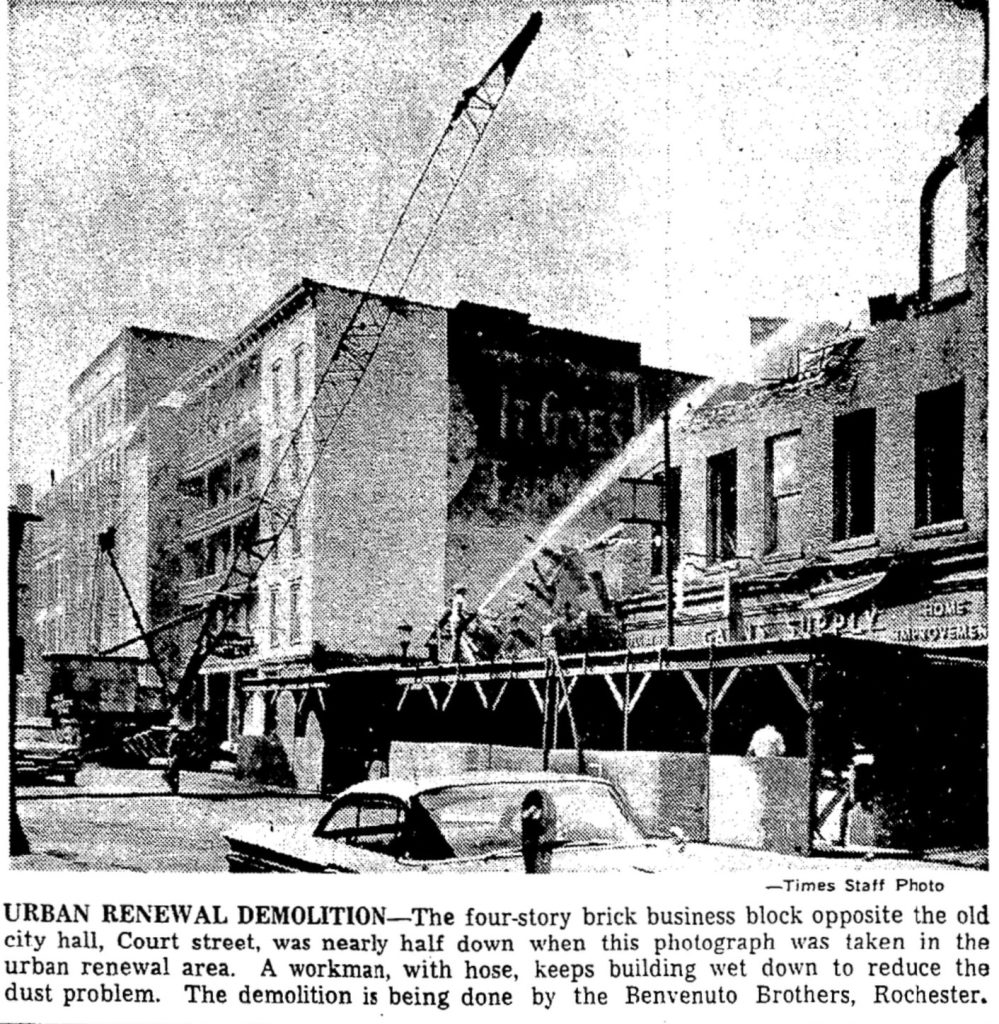
Councilmen Rand stated in The Times, “it is now into April and a majority of the properties still have not been acquired.” The city council voted to start condemnation proceedings before September against eleven proper owners. Still, only one, The Roosevelt Hotel, had even been started, which resulted in the recommendation the owner be paid $15,000 more than the initially proposed price.
As of May, 10th, the following buildings were scheduled to be razed during the summer of ’66:
The New Roosevelt Hotel, Court Street.
The former Manfred Garage at Arsenal and Jackman Streets, leased to Family Bargain Center.
The Avon Theater, Arsenal Street.
The Fuess Block, Court and King Street.
Three properties formerly owned by the Krupkin Realty and the Chippe Krupkin estate on Court and Jackson Streets.
Jerry’s Hotel, Court Street.
An abandoned house on Jackson Street at the rear of the Globe Store.
The S&B Diner on Court Street.
The old concrete building at the rear of the former state armory.
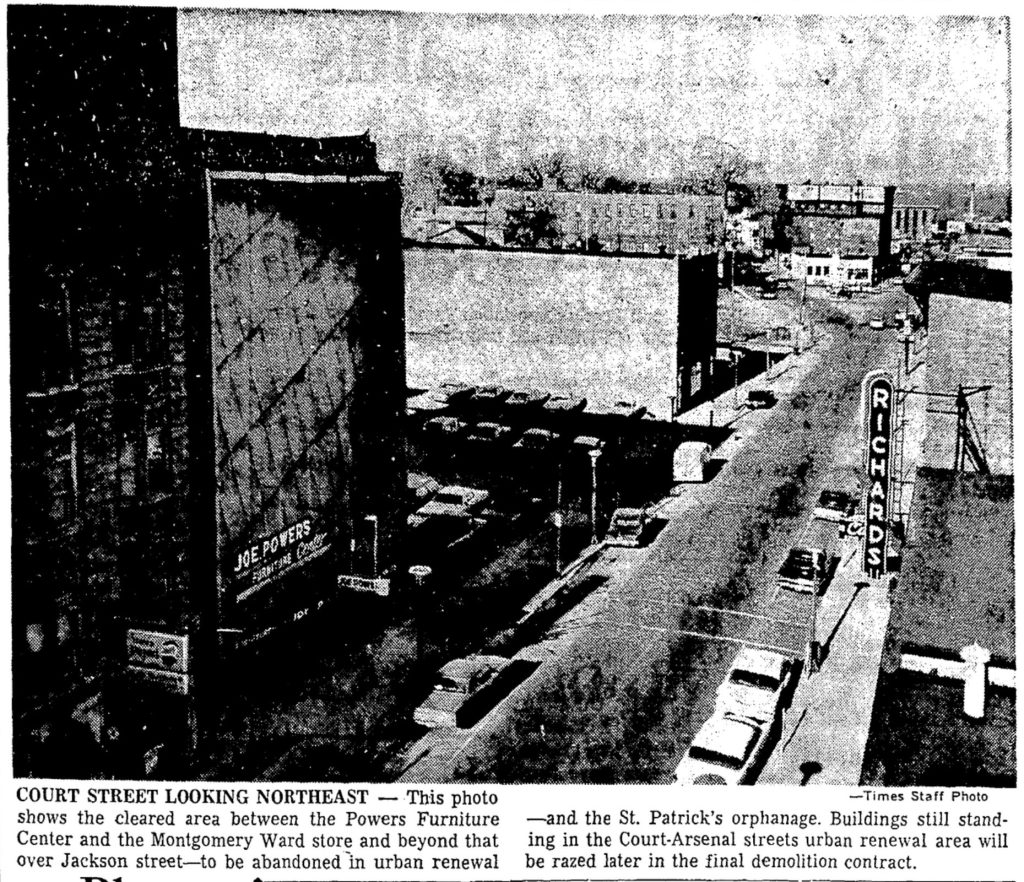
By mid-June, the city had acquired 37 of the 44 properties, while August saw the 2nd bid for the second phase of the Court-Arsenal Street demolition awarded to the Benvenuto Brothers, Inc. The city council accepted their bid for $144,400, the lowest of two bids. The Benvenuto Brothers also had rights to salvaging material in addition to the contract, which was below the estimated $162K for the job to clear nearly half of the 18.5-acre site. The third bid, issued in January of 1967, was awarded to S.A.S. Equipment Company, Inc., North Bergen, N.J., which submitted the lowest bid for $113,150, outbidding nine competitors.
Also in August, the new urban renewal plan, which gave more flexibility to developers and axed the Sherman Street extension, initially included, would cost the city as much as another $100,000 with $800,000 added overall.
The cost per sq. ft. to developers would be dropped to $2, rather than the $6 originally proposed, which was called a “more realistic figure.”
In September of 1966, Watertown’s Court-Arsenal Streets urban renewal development, state and federal government-financed to the extent of 87.5%, has a new gross budget of $7,101,536, of which local residents will ultimately pay an estimated $621,992 as the municipal share through a bond issue. The original Watertown urban renewal budget totaled $5,785.020.
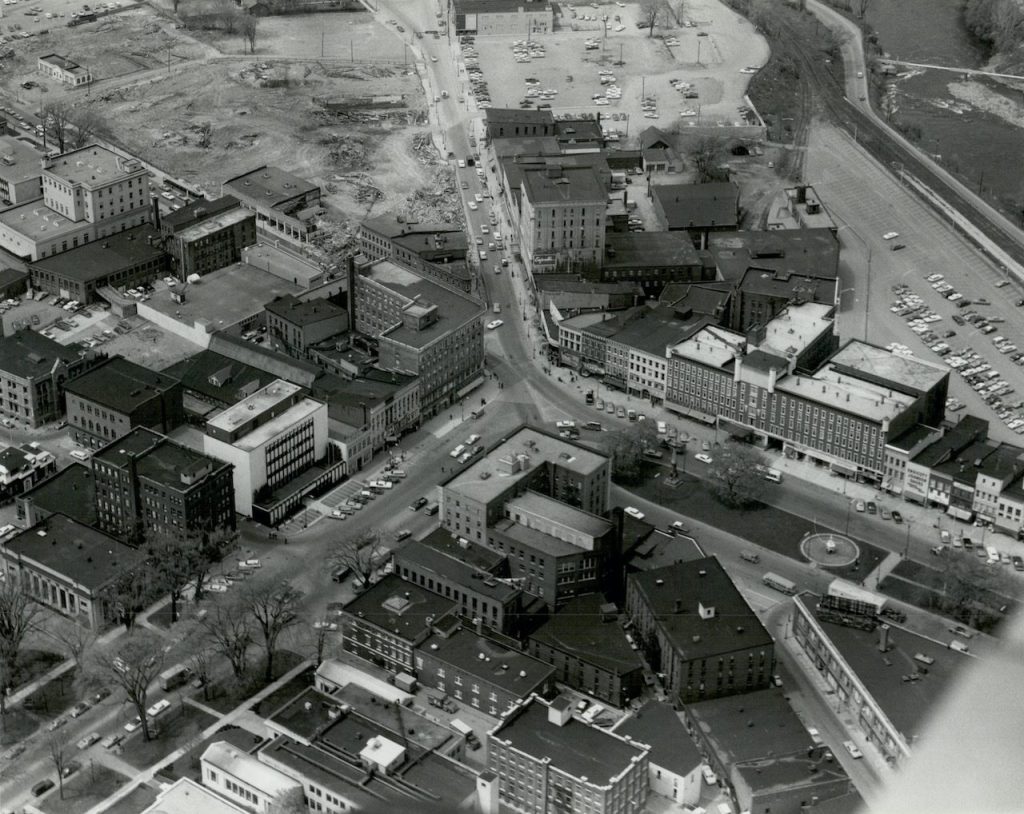
The city council also voted to approve plans for the urban renewal commercial development and set May 30, 1968, as the completion for construction by private developers, once again putting the cart before the horse by not having its ducks in a row. Yes, only in a zoo, or perhaps a three-ring circus, would you find such decisions being made.
Early 1967 didn’t see much better news to start with, either. Campanelli Investment Properties, one of two private developers interested in the project, withdrew from the local field, citing their current schedule of commitments. This may have resulted from the city council’s assumption that construction should be completed by the middle of the following year. However, by this point, everything was at least two years behind where it was initially expected, not to mention there were still buildings needing demolition.
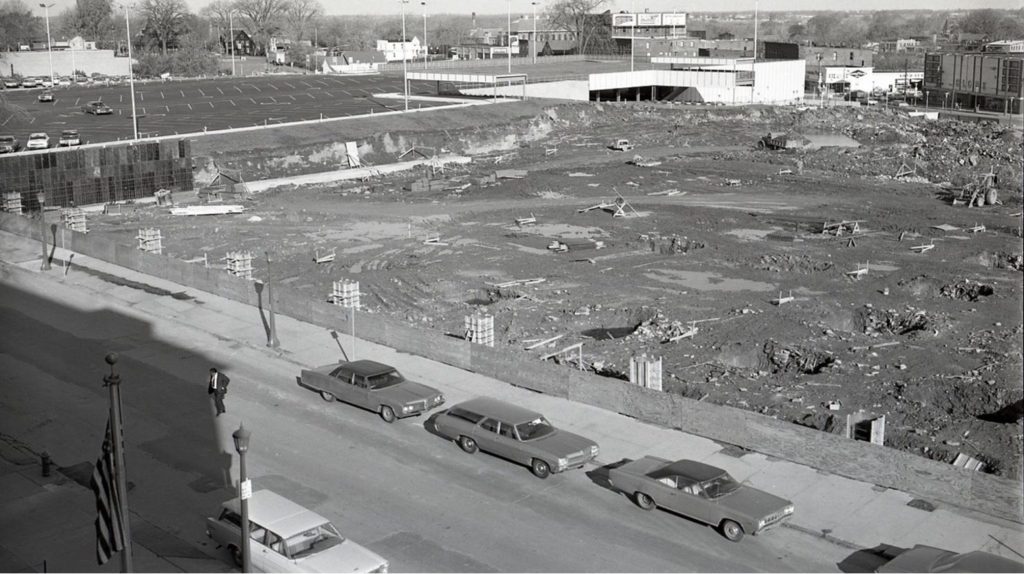
Finally, March 13the saw the announcement of the last demolition phase, to begin with the following buildings available, with more to come in the following weeks–
Montgomery Ward, Court Street
Bradley Block, Arsenal Street
Humble Oil building, Court-Coffeen Streets
Avon Theater, Arsenal Street
Household Merit, Court Street
Jerry’s Hotel, Court Street

Just a few days prior, the Watertown Daily Times announced the state armory’s days were numbered–
The city’s urban renewal department today officially turned the old armory building over to the New Jersey demolition contractor.
The official action bars further private and municipal use of the former armory, said Anthony F. Vallone, urban renewal director.
The city council, at an executive session at city hall Monday night, acquised (sic) with the decision to turn over the old building for razing.
The armory is one of the buildings left in the Court-Arsenal Streets urban renewal area. It was supposed to have been the last building to fall before the demolition.
However, said Mr. Vallone, getting the Bradley store—a major demolition contract keystone—out of the urban renewal sector has mandated turning over the former armory now to fulfill the city’s demolition.
Holding up the demolition was constructing a new building for the Bradley Store on Newall Street, keeping their current store occupied.
And with that, the majority of the demolition work would be completed. For more information on the development of the property, much has been documented on the new Woolworth store’s construction.

Urban Renewal – Letter To The Editor 20 Years Later
An attempt was made to find any articles in the Watertown Daily Times written 20 years after the Watertown urban renewal effort. While a retrospective piece may exist in a different era, none could be found. There may also exist articles that state the final cost, but I think most people don’t need dollars and cents to express their thoughts on urban renewal.
However, below is a letter to the editor published nearly 35 years ago on July 16, 1987, titled “Downtown Dying.”
We taxpayers are paying nearly a million dollars now for a big “faux pas” done under the heading of “urban renewal.” This was supposed to make our little town more efficient and prosperous. Along with this came a “multi-level parking garage” across from the Globe Store on Court Street. One problem: Mr. Forbes had it built in mid-winter of cement which doesn’t take to freezing weather, and this great idea collapsed as soon as it was built!
Do you remember urban renewal? How it changed Court Street, and supposedly helped businesses? Joe Powers Furnitures left; the lovely Bee Hive left, that great little store where you could find about anything, especially for gifts; the movie house on Arsenal is gone. Sydney Miller Shoe Store, gone, Bradley’s Hardware, etc.
A new store for our town and we are still paying for it. Aren’t you glad? Higher assessments, water and sewer rates and that garage! Oh heck, it’s only money. Now w have a new mall movie house, several shopping plazas, food alley on Arsenal Street. We are growing up and paying for it. Our house value was just raised $10,000. The Fort Drum explosion and our downtown is dying.


